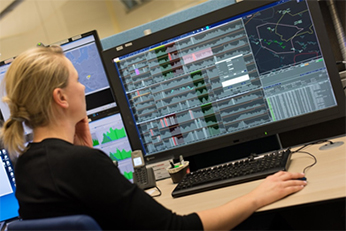
SESAR members and partners have demonstrated a digital tool that provides air traffic control centres across Europe with a shared view of expected traffic, and the means to better control the demand and flow of flights in their portion of airspace. The tool also enables greater data analysis on the effectiveness of measures to manage traffic at a network level.
The digital tool was tested by Eurocontrol’s Network Manager Operation Centre (NMOC) and the flow managers at the Maastricht Upper Airspace Unit (MUAC) in the Netherlands within the context of Network Collaborative Management (PJ24), a very large-scale demonstration funded by SESAR 2020 in the framework of Horizon 2020.
The NMOC is responsible for centralising flight plan management in Europe, offering an accurate picture of the air traffic on any given day. When the demand for the airspace outweighs the capacity, local air traffic control centres can request from the NMOC a so-called “regulation” to introduce an air traffic flow and capacity management or ATCFM measure in order to balance the demand through re-routing, controlling the time of arrival, etc.
Until now, these regulations have been coordinated with the NMOC by phone. While successful, this manual approach has several shortcomings, notably that there is no shared view nor easy traceability of the requested regulations. Aiming to address these limitations, the tool developed by SESAR members and partners offers a digital service through which regulations can now be created, shared, coordinated, modified and cancelled with a click of a button.
The SESAR demonstration showed how the digital exchange of regulation information can save time while also reducing errors in the workflow process. Those testing the tool also found that it was easier to combine regulation coordination with other time-critical operational tasks. The integration of regulation information into a local and network tool also enabled the flow managers in MUAC and the NMOC to monitor each regulation and its impact, as the traffic situation evolves.
Furthermore, thanks to the possible addition of “what if” functionalities, the impact of a regulation can be assessed before it is put in place. Finally, the gathering of so much data opens up new possibilities to conduct more in-depth post-operational analytics on the regulation use, helping to ensure that regulations are applied optimally in the future.
The digital tool is part of the set of solutions under investigation by the demonstration partners to enable a more dynamic approach to network coordination and to dealing with network constraints.
More about the project:
http://www.eurocontrol.int/articles/network-collaborative-management-sesar-2020-project-pj24
